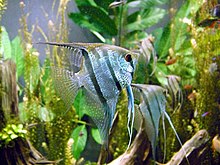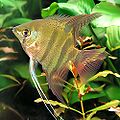
Cichlids are fish from the family Cichlidae in the order Cichliformes. Traditionally Cichlids were classed in a suborder, the Labroidei, along with the wrasses (Labridae), in the order Perciformes, but molecular studies have contradicted this grouping. On the basis of fossil evidence, it first appeared in Tanzania during the Eocene epoch, about 46–45 million years ago. The closest living relative of cichlids is probably the convict blenny, and both families are classified in the 5th edition of Fishes of the World as the two families in the Cichliformes, part of the subseries Ovalentaria. This family is large, diverse, and widely dispersed. At least 1,650 species have been scientifically described, making it one of the largest vertebrate families. New species are discovered annually, and many species remain undescribed. The actual number of species is therefore unknown, with estimates varying between 2,000 and 3,000.
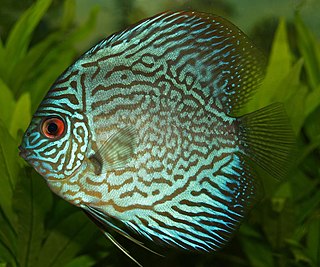
Symphysodon is a genus of cichlids native to the Amazon river basin in South America. Due to their distinctive shape, calm behavior, many bright colors and patterns, and dedicated parenting techniques, discus are popular as freshwater aquarium fish, and their aquaculture in several countries in Asia is a major industry. They are sometimes referred to as pompadour fish. The discus fish has attracted a cult following of collectors and has created a multimillion dollar international industry complete with shows, competitions, and reputable online breeders.

The neon tetra is a vibrant freshwater fish from the Amazon basin, renowned for its bright blue and red stripes, making it a favorite among aquarium hobbyists. In the wild, it inhabits warm, acidic waters in blackwater and clearwater streams, avoiding whitewater rivers. Distinguished by its iridescent coloration, which changes with light conditions, the neon tetra exhibits slight sexual dimorphism in its body shape and stripe curvature. First described in 1936, it is now a staple in the aquarium trade, primarily farm-raised in Southeast Asia. Neon tetras require specific water conditions and thrive in groups within well-planted tanks. They have an omnivorous diet, including small aquatic foods. Breeding in captivity is challenging and they are prone to neon tetra disease, an often fatal condition. Proper care and preventive measures are crucial for their health in aquariums.

Marine angelfish are perciform fish of the family Pomacanthidae. They are found on shallow reefs in the tropical Atlantic, Indian, and mostly western Pacific Oceans. The family contains seven genera and about 86 species. They should not be confused with the freshwater angelfish, tropical cichlids of the Amazon Basin.

Pterophyllum scalare, most commonly referred to as angelfish or freshwater angelfish, is the most common species of Pterophyllum kept in captivity. It is native to the Amazon Basin in Peru, Colombia, and Brazil. Particularly to the Ucayali river in Peru, the Oyapock River in French Guiana, the Essequibo River in Guyana, the Solimões, the Amapá, and the Amazon rivers in Brazil. It is found in swamps or flooded grounds where vegetation is dense and the water is either clear or silty. Its native waters range from a neutral pH of 7.0 down to near 6.0, with a general water hardness (gH) range of 3 to 10 °dH, and water temperature ranging from 26 to 30 °C. This is the species of angelfish most frequently found in the aquarium trade. A similar P. scalare exists in the Rio Orinoco. They are of the same size and shape, the only difference being the stripes; the Orinoco P. scalare has thinner, but dual, stripes.
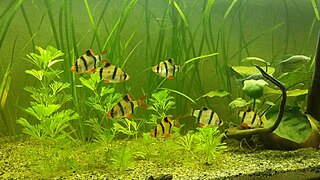
The tiger barb or Sumatra barb, is a species of tropical cyprinid fish. The natural geographic range reportedly extends throughout the Malay Peninsula, Sumatra and Borneo in Indonesia, with unsubstantiated sightings reported in Cambodia. Tiger barbs are also found in many other parts of Asia, and with little reliable collection data over long periods of time, definite conclusions about their natural geographic range versus established introductions are difficult. Tiger barbs may sometimes be confused with Puntigrus anchisporus, Puntigrus navjotsodhii, or Puntigrus partipentazona, which are similar in appearance, the only differences being the slightly different stripe pattern and the number of scales these fish have.

The black ruby barb or purplehead barb is a tropical cyprinid fish endemic to Sri Lanka, where it occurs in forested streams from the Kelani basin to the Nilwala basin. They are found in streams on hills around 1000 ft in elevation. The brightly colored population introduced to Mahaweli at Ginigathena, Sri Lanka, is said to have diminished in number due to the aquarium export trade.

Pterophyllum altum, also referred to as the altum angelfish, deep angelfish, or Orinoco angelfish, occurs strictly in the Orinoco River Basin and the Upper Rio Negro watershed in Southern Venezuela, Southeastern Colombia and extreme Northern Brazil.

Pterophyllum leopoldi, also referred to as the teardrop angelfish, Leopold's angelfishdwarf angelfish, or roman-nosed angelfish, is an angelfish species native to the Amazon River, Essequibo River and Rupununi River.

The Serpae tetra, also known as the Red Minor tetra, Jewel tetra or Callistus tetra, is a species of tetra, a tropical freshwater fish of the characin family of order Characiformes. It is native to the Amazon River drainage in Brazil, Peru, Paraguay, Bolivia and northern Argentina. The fish can be found in slow moving or still backwater including, ponds, small lakes, and streams. In the wild, it forms aggregations around vegetation and tree roots, and thrives when the water temperature is22–27 °C (72–81 °F).

Puntigrus partipentazona, the Dwarf Tiger Barb, is a species of cyprinid fish native to Southeast Asia where it is found in the Mekong, Mae Klong, and Chao Phraya basins of Thailand, the Malay Peninsula, and coastal streams of southeast Thailand and Cambodia where it occurs in streams and impoundments with dense weed growth. It can also be found in the aquarium trade. It is frequently misidentified as the similar Puntigrus tetrazona.

The rummy-nose tetra is a species of tropical freshwater characin fish originating in South America, popular among fishkeepers as a tropical aquarium fish. One of many small tetras belonging to the same genus, it is on average 5 cm (2 in) long when fully grown. The fish is one of several very similar species including Petitella bleheri, and Petitella georgiae, and it is possible that more recently collected specimens available in the aquarium trade are members of one or other of these similar species. The common name applied to most of these fishes is "rummy-nose tetra", though other common names are in circulation.
The bloodfin tetra is a species of characin from the Paraná River basin in South America. The bloodfin is a relatively large tetra, growing to 5.5 cm. Its notable feature is the blood-red colouration of the tail, dorsal, anal and adipose fin, while the body is silver in color.

The Buenos Aires tetra is a tropical fish from South America. It was first observed in the wild in 1907, by Carl H. Eigenmann.

Hemigrammus erythrozonus, commonly known as the glowlight tetra, is a small tropical fish from the Essequibo River, Guyana, South America. It is silver in colour and a bright iridescent orange to red stripe extends from the snout to the base of its tail, the front of the dorsal fin being the same color as the stripe. Other fins are silver to transparent. The glowlight tetra is a peaceful, shoaling fish. It is larger than the neon tetra, and its peaceful disposition makes it an ideal, and popular, community tank fish. It should be kept with similar sized, non-aggressive species. Hemigrammus gracilis is a senior synonym. The red-line rasbora of Malaysia and Indonesia has markings and coloring very similar to H. erythrozonus, but is a member of family Cyprinidae, not a close relative.
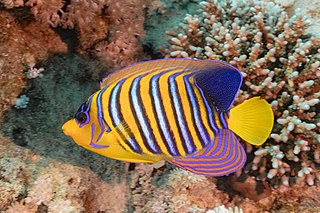
The royal angelfish, or regal angelfish, is a species of marine ray-finned fish, a marine angelfish belonging to the family Pomacanthidae, and the monotypic genus Pygoplites. It is found in tropical Indo-Pacific oceans. It can grow as long as 25 cm.
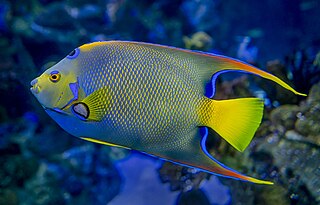
The queen angelfish, also known as the blue angelfish, golden angelfish, or yellow angelfish, is a species of marine angelfish found in the western Atlantic Ocean. It is a benthic warm-water species that lives in coral reefs. It is recognized by its blue and yellow coloration and a distinctive spot or "crown" on its forehead. This crown distinguishes it from the closely related and similar-looking Bermuda blue angelfish, with which it overlaps in range and can interbreed.
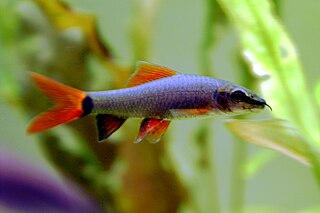
The rainbow shark is a species of Southeast Asian freshwater fish from the family Cyprinidae. It is also known as the ruby shark, red-fin shark, red-finned shark, rainbow sharkminnow, green fringelip labeo, whitefin shark and whitetail sharkminnow. It is a popular, semi-aggressive aquarium fish. Unlike true sharks, which belong to the Chondrichthyes lineage, the rainbow shark is an actinopterygiian.
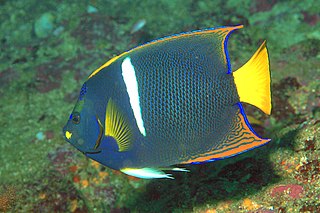
Holacanthus passer is a large marine angelfish of the family Pomacanthidae. Its large size and bright colors make it a popular aquarium fish, even though it can be difficult to keep.

The black-winged hatchetfish is a freshwater ray-finned fish native to South America.
